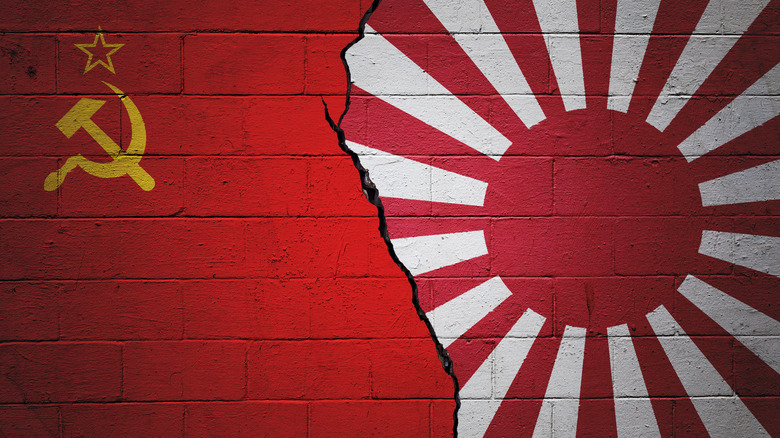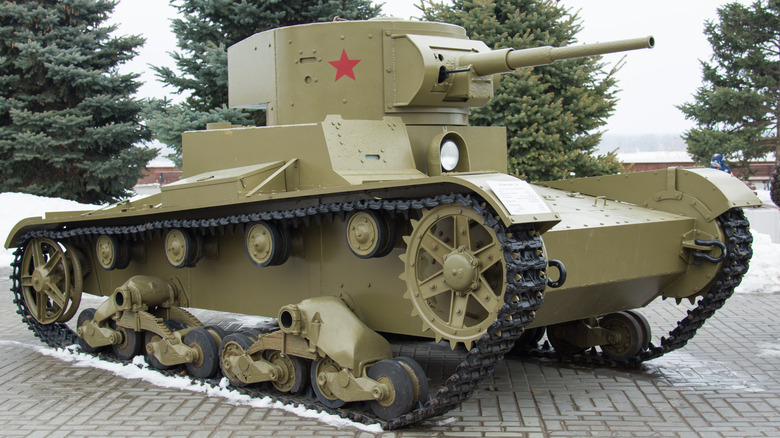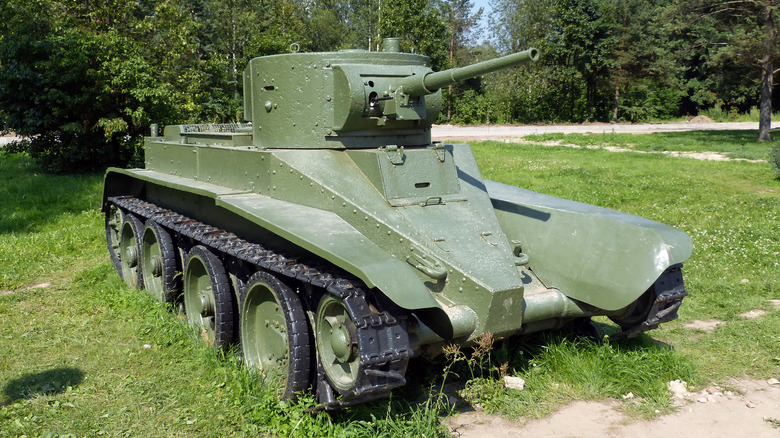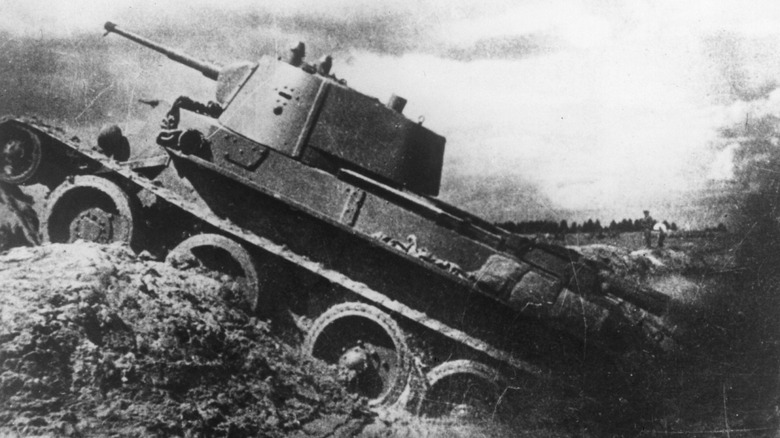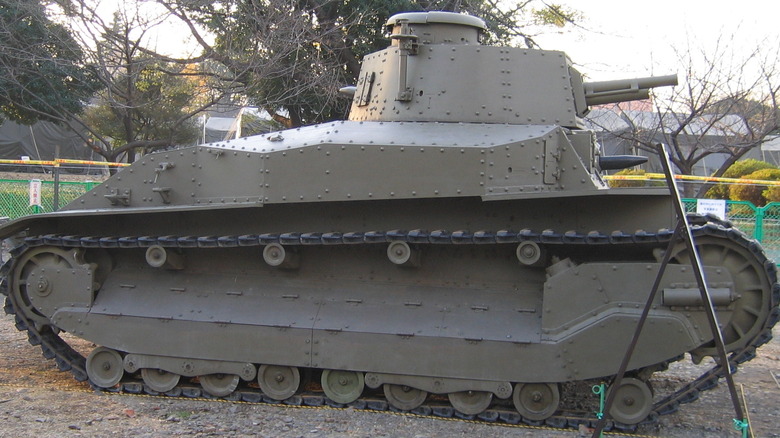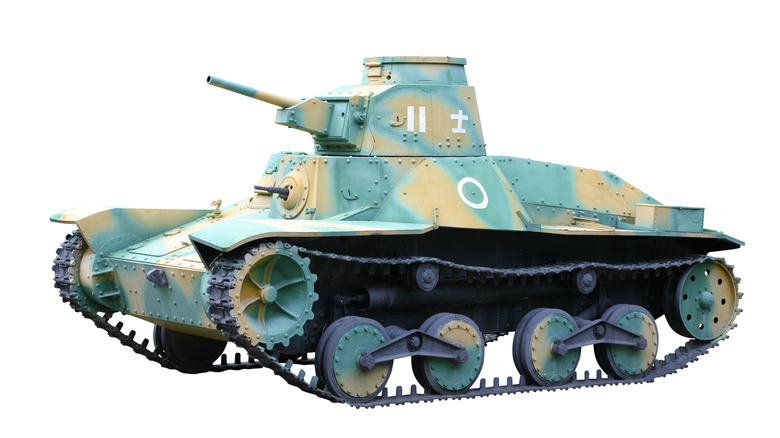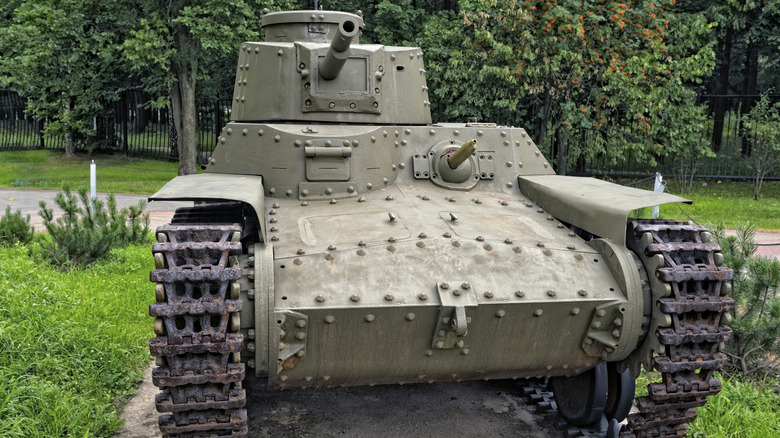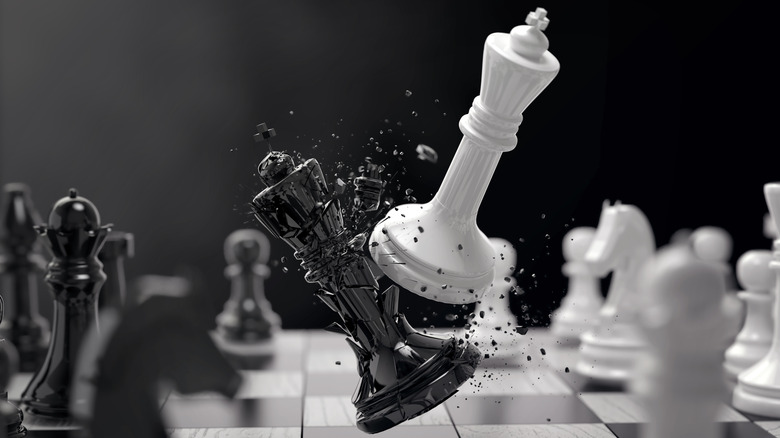A Look At The Tanks Involved In The Battle Of Khalkhin Gol
During the 1930s, the planet rumbled with militaristic antagonism, but World War II wasn't the only conflagration of the decade. In an oft-forgotten conflict, two old enemies participated in one of the most significant tank battles in history years before Germany invaded Poland. The Soviet Union and Japan already had a history of conflict. Decades before, the Japanese had dealt a significant blow to the Russian Imperial Navy, seizing Port Arthur during the Russo-Japanese War.
In 1931, Japan seized Manchuria, a resource-rich region in Northeast Asia, and established a 3,000-mile disputed zone between its occupied territory and the Soviet Union. This uneasy tension built for much of the decade, initially erupting into the Battle of Lake Khasan in July 1938, and almost a year later into the Battle of Khalkhin Gol.
The battle kicked off in May 1939, when a handful of Soviet cavalrymen seeking grazing grounds for their horses blundered into Japanese territory, shattering a very fragile ceasefire. The Battle of Khalkhin Gol had enormous consequences for the Second World War — the Soviet victory meant it had one less front to fight on when the war began in earnest — and for the political philosophies of the combatants as well. Battle tanks played a major role in this conflict: Here are the ones most involved in the Battle of Khalkhin Gol.
T-26
The T-26 was the Soviet Union's primary interwar tank. Seeking a balanced, inexpensive, and updated alternative to the increasingly obsolete T-18, the Soviets identified the British Vickers Mark E as a potential solution. Ordering 15, Soviet engineers traveled to the Vickers plant in May 1930 to record their assembly. Taking what they learned back home, by 1931, the domestically produced Soviet T-26 was in production.
The T-26 was the most-built tank of the following decade. Between 1931 and 1939, over 10,000 rolled off the assembly line. By 1933, The T-26 sported a single-turret housing a high-velocity 45mm gun called the 19K and 122 rounds of ammunition. It also carried around 3,000 rounds for a pair of 7.62 coaxial machine guns, with a third added in 1935. These machine guns would prove instrumental in eliminating anti-tank teams and suicide charges at Khalkhin Gol. A flat four-cylinder air-cooled engine pushed the tank forward with 90 brake horsepower (bhp). Several variants with slight differences in communication abilities and equipment for particular tasks were also outfitted.
Though only a few dozen T-26s were reportedly stationed with the 57th Special Corps and 1st Army Group at the Battle of Khalkhin Gol, they fared well there. The Japanese 37mm anti-tank gun could penetrate the T-26's thin armor, but crews reported good survivability in such cases. The T-26s played a crucial role in Soviet officer Zukhov's mobile envelopment of Japanese forces, and they went on to be an early tank that shaped the course of World War II.
BT-5 Cavalry Tank
The BT-5 Cavalry Tank debuted in 1933 as an improvement on previous models, which themselves were based on the American Christie M1928. Powered by a Mikulin M5 engine with 400 hp, the BT-5 was younger than the T-26, coming into mass production in 1933, and shared the same 45mm gun.
However, what the BT-5 gained in speed, it sorely lacked in protection. Armor ranging in thickness from 6 to 13 millimeters was nothing compared to the tanks that fought in the Battle of the Bulge five years later. The theory was that the reduced weight and powerful engine would combine to make the BT-5 too fast to be targeted by anti-tank guns or enemy armor. The BT-5 weighed 11.5 tons, including a full battle load of 115 main gun rounds and five coaxial machine guns and their ammo. With a power-to-weight ratio of 35 hp for every tone, it could achieve top speeds of around 45 mph.
The Soviet command sent BT-5s to all armored cavalry brigades beginning in 1933. Crews cut their teeth in the Spanish Civil War. The quick, lightly armored tank befuddled Japanese anti-tank teams, and tank crews learned to fear the punch of its 45mm gun. However, it proved vulnerable to attacks from close-up infantry bearing Molotov cocktails, with a well-placed firebomb igniting the gasoline engine causing it to explode.
BT-7 Cruiser Tank
In the same family as the BT-5, the BT-7 Cruiser shared the American Christie tank lineage, with a few Soviet alterations. Also considered a "fast tank" type, the BT-7 sported 6 to 22-millimeter armor. The 1935 model shared a turret with the T-26 and the 45mm 20k gun. Post-1937, the BT-7 received its own conical turret, better at deflecting rounds and including additional ammunition storage, along with an up-gunned 75mm short-barreled KT-26 cannon.
A Mikulin V12 M15T/M17T gasoline engine provided 405 horsepower and a top speed of 45-53 mph on the road and 31 mph off-road. The 6th and 11th Tank Brigades took the BT-7 into battle at Khalkhin Gol. Nearly 400 BT-7s were involved in the fight between May and August 1939. They proved to be capable tanks, even serving in the initial stages of the German invasion of the Soviet Union, but were soon outclassed by the new generations of war machines that would fight in World War II.
Type 89 I-Go
In 1925, the Japanese military began designing its light tank prototype. The General Staff Office rejected several models, including one based on the design of the British Vickers Medium Mark C, the Type 87. Eventually, it settled on the Type 89A I-Go, a model based on revisions to the Type 87 prototype. The design evolved, and by the time of Khalkhin Gol, the Japanese were fielding the Type 89B I-Go.
Powered by a Mitsubishi A6120VD 6-cylinder air-cooled gasoline engine, the most potent Type 89 model produced 120 hp and increased torque over the A-model. The more powerful model could attain 16 mph with a range of 110 miles. The Type 89 sported a 57mm medium-velocity with 100 round capacity, depending on the model. Later models got the Type 90 cannon — still 57mm but with a longer barrel.
Despite the Type 89 tank's rapid obsolescence by the time of the Battle of Khalkhin Gol, it still made a significant impact. A total of 34 tanks participated in the battle, overrunning Soviet positions and penetrating enemy territory. While a dozen tanks suffered battle damage, they were promptly repaired and continued to serve before withdrawing from the field. The Type 89 was a testament to the growing prowess of the Japanese military, being amongst its first domestically produced battle tanks.
[Featured image by Sturmvogel 66 via Wikimedia Commons | Cropped and scaled | CC BY 3.0 DEED]
Type 95 Ha-Go
The upcoming war would require lightning-fast maneuvers, and the Type 89 in the Japanese arsenal was often criticized as an "infantry-paced" piece of armor. High Command quickly realized that it required a speedier and more robust tank. By 1935, Japanese military engineers finalized plans for the Type 95 Ha-Go Light Tank. Relatively lightweight at a mere 7 tons, the 110 bhp Mitsubishi engine pushed it to a max speed of 28 mph.
Tank operators primarily employed the 37mm medium-velocity cannon against infantry, though its armor-piercing rounds could penetrate up to 25 millimeters of armor at 500 meters. Its armor was relatively thin, though standard for speedy tanks of the interwar years, ranging 6 to 16 millimeters thick. The Japanese deployed their early Type 95s to the Chinese/Manchurian theater in 1935 as part of their Mixed Mechanized Brigade. Their first combat action occurred in the Shanxi Province, mainly in infantry combat.
The Type 95 first faced enemy armor at Khalkin Gol as part of the 1st Tank Group. The Japanese forces attacked the Soviet 914th Motor Rifle Regiment and 8th Mechanized Brigade. Though they initially succeeded in breaking the Soviet line, the follow-up counterattacks decimated the troops. The 45mm guns of the enemy tanks proved too much for the armor of the Type 95s, with the Soviets ultimately destroying 42 out of 73 tanks.
Type 97 Chi-Ha
In 1938, The Japanese government sought a modern tank suited to the fast, mechanized battles of what would become World War II and tasked Mitsubishi Heavy Industries with developing the Type 97. The Chi-Ha became one of the workhorses of the Japanese military. With 2100 units, it was the second most produced tank of the Imperial war machine.
Sporting the same 57mm gun as the Type 95 Ha-Go, the Type 97 was faster and better armored. A crew of four operated the machine at speeds up to 24 mph under the power of a 170 hp diesel V12 produced by Mitsubishi. The Chi-Ha needed the extra power. It weighed around 15 tons due partly to armor that ranges in thickness from 12 to 25 millimeters.
In the initial invasion of China, the inferior Chinese armor of the National Revolutionary Army proved no match for the Type 97. Fighting the Soviets proved another matter entirely. In the Battle of Khalkhin Gol, only four Type 97s were deployed. The Soviet high-velocity guns and their superior range made short work of them. At least one fell victim to a tank trap, after which several BT-5s and BT-7s shot it. Overall, the Japanese armor on the field at Khalkhin Gol was severely outnumbered and badly outclassed by the Soviet tanks, most of which were a generation ahead technologically.
The aftermath
The carnage accompanying World War II, which officially started months later, often overshadows the Battle of Khalkin Gol. But it remains a critical fight in a century when tanks were the biggest bully on the battlefield, even though some experts are calling them useless in the modern age. The Soviets scored a decisive victory. In the process, they operated their armies in a combined arms mode for one of the first times, learning many lessons they would take to the fight against the Germans upon the invasion of the Soviet Union in June 1941.
The Japanese also learned a crucial lesson. Their defeat at the Battle of Khalkhin Gol signaled the beginning of the end of their imperialistic adventure on the Asian landmass. Henceforth, the Japanese would not look westward for its next expansion, but east. Theirs would be a Pacific empire, as the might of the Soviet Union in Manchuria had deterred them. Six months after Nazi Germany invaded the Soviet Union, the Japanese Imperial Navy missed landing a death blow to the U.S. fleet at Pearl Harbor.
Some historians claim that World War II started with the Japanese invasion of Manchuria. If so, the Battle of Khalkin Gol marks a critical turning point in the strategy of one of the most potent Axis forces. Both nations would take the lessons learned to new theaters, develop new tactics and strategies, and set the world on fire.
